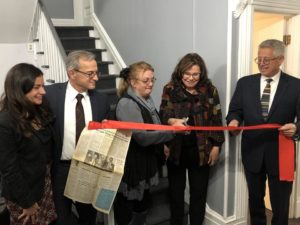Historic Newton building rebrands as co-op

Please click here to read the original article, published by the NJ Herald and written by Kyle Morel.
NEWTON – The building located at 49 High Street in Newton has been home to several businesses and residences since it was first constructed exactly two centuries ago.
First used as a residential dwelling, it has also housed a millinery, a medical office and, for the past 25 years, a law firm. Now, it has taken on yet another form accompanied by a new name: Courthouse Plaza.

From left, attorney Racquel Hiben; her father and law partner, attorney Chris Colabella; Newton Councilwoman Sandra Diglio; Freeholder Sylvia Petillo; and attorney Mark Gruber take part in a ribbon-cutting ceremony for the newly renovated Courthouse Plaza on High Street in Newton Tuesday, Nov. 12. [Photo by Kyle Morel/New Jersey Herald]
The building was in need of some improvements in recent years, Gruber explained, and when firm partner Carmen Liuzza passed away last December, the founders decided to “breathe some new life” into the building. Thus, the idea of an “office co-op” was born, with the law firm using one satellite office of the three-story building and the rest available to other tenants.
“The place is pretty much ready for a professional – an accountant, lawyer, therapist, small business – to come in, rent the place for a week, a month, a year,” Gruber said.

Mark Gruber, a partner of the Gruber, Colabella, Thompson, Hiben & Montella law firm, holds a brick inscribed with the year 1819, when the building housing the firm at 49 High Street in Newton was constructed. [Photo by Kyle Morel/New Jersey Herald (NJH)]
One of the unique features of the building, McCabe noted, is a “door to nowhere” on the landing leading up to the second floor, which presumably became obsolete following the addition. McCabe surmised that the door had been previously used by paid servants who lived in the house to get from the kitchen to their quarters on the third floor.
Tuesday’s ceremony also served as somewhat of a crash course from McCabe in how to conduct historical research. For instance, he taught the attendees to determine the approximate date of a building by looking out for styles of screws, doorknobs and other features popular of certain time periods.
“Try to come up with an analysis of, what does each one of these things mean? And when you take them together as a whole, what does that tell you about the building?” McCabe said.
The historian also highlighted the importance of looking at photographs and maps as well as conducting title searches to find previous owners of a property.
“These are the kind of things that, as a historian, you have to look at and try to follow up and chase down information and leads,” McCabe said. “Then you put your package together and you say, ‘This is what’s happened with this building, or at this site, or in this neighborhood,’ and how does that relate to the entire community? And that’s really the fun part of it.”
Having received a sufficient understanding of the history of the building, the partners of what is now the Gruber, Colabella, Thompson, Hiben & Montella law firm are looking forward to future partnerships with various merchants at the location.
“All they need is a laptop to plug in and they’re ready to go. That’s the vision, and we hope that it will catch on,” Gruber said. “There’s a lot of people, professionals and others, that want to have a presence in Sussex County, and I think this would provide it. You won’t find a more charming building – right in, pretty much, the center of town, with all the parking out there, beautiful buildings – so we hope it takes off.”
